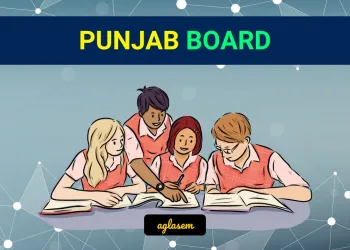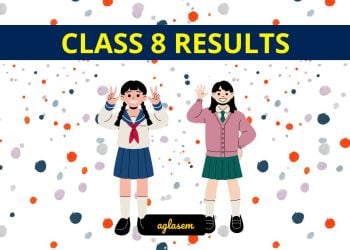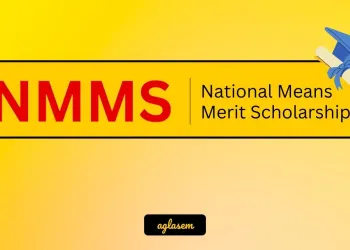Candidates can download NCERT Exemplar Class 8 Science Unit 18 from this page. The exemplar has been provided by the National Council of Educational Research & Training (NCERT) and the candidates can check it from below for free of cost. It contains objective, very short answer type, short answer type, and long answer type questions. Along with it, the answer for each question has also been provided. From the NCERT Exemplar Class 8 Science Unit 18, candidates can understand the level and type of questions that are asked in the exam.
NCERT Exemplar Class 8 Science Unit 18 Pollution of Air and Water
NCERT Class 8 Science Unit 18 is for Pollution of Air and Water. The type of questions that will be asked from NCERT Class 8 Science Unit 18 are displayed in the below provided NCERT Exemplar Class 8 Science Unit 18. With the help of it, candidates can prepare well for the examination.
Also Check: NCERT Solutions for Class 8 Science
Multiple Choice Questions
- Air is a mixture of various gases. One of the gases is 21% part of the air and is essential for the survival of human beings. This gas is
(a) nitrogen
(b) oxygen
(c) ozone
(d) argon - Which of the following is not a source of air pollution?
(a) automobile exhaust
(b) burning of firewood
(c) windmill
(d) power plant - Boojho wishes to contribute in reducing air pollution. Which vehicle should he use for going to school?
(a) car
(b) school bus
(c) autorickshaw
(d) scooter - Which of the following is not a way to conserve water?
(a) replace
(b) reduce
(c) reuse
(d) recycle - The type of pollution which is likely to affect Taj Mahal in Agra to a greater extent is
(a) air pollution
(b) water pollution
(c) soil pollution
(d) noise pollution - Incomplete combustion of fuel such as petrol and diesel gives
(a) nitrogen oxide
(b) sulphur dioxide
(c) carbon monoxide
(d) carbon dioxide - The phenomenon of marble cancer is due to
(a) soot particles
(b) CFCs
(c) fog
(d) acid rain - Potable water is the water which is
(a) obtained from a river.
(b) obtained from a lake.
(c) pure and fit for drinking.
(d) used only for washing clothes. - Which of the following procedures will give you water free from all impurities?
(a) adding chlorine tablets
(b) distillation
(c) boiling
(d) filtration - A pond contains clean water. Which of the following activities will produce least pollution of water?
(a) washing clothes in the pond
(b) animals bathing in the pond
(c) washing motor vehicles in the pond
(d) swimming in the pond. - Trees help in reducing the pollution of our environment. Lakhs of trees are planted by people in the month of July every year.
The occasion is called
(a) forest Conservation Day
(b) plantation month
(c) Van Mahotsav
(d) wildlife week - Which of the following is not a green house gas?
a) nitrogen gas
(b) water vapour
(c) methane gas
(d) carbon dioxide
Very Short Answer Type Questions
- Name the chemicals which are used in refrigerators and air conditioners and damage ozone layer when released in air.
- Name any two sources which cause air pollution due to suspended particulate matter.
- Name two gases which are mainly responsible for acid rain?
- The quality of air at various locations is monitored regularly by government and other agencies? In what way can you use these data?
- Combustion of fossil fuels generates a lot of air pollution. Can you suggest any two alternative sources of energy which do not cause any pollution?
- Name any two water pollutants which are toxic for plants and animals.
Short Answer Type Questions
- A lot of dry leaves are collected in a school garden and are burnt every day. Do you think that it is right to do so? If not, what should be done to dispose off the dry leaves?
- The level of air pollution is higher at a busy traffic intersection. Why?
- Fill in the blanks with the help of words given in bracket after each sentence.
(a) When air is contaminated by ________ substances which have a ________ effect on both the ________ and ________, it is referred to as ________. (air pollution, harmful, living, unwanted, non-living, pollutants).
(b) Many ________ are responsible for causing ________ pollution. Petroleum ________ are a major source of ________ pollutants like ________ and ________. (sulphur dioxide, refineries, industries, nitrogen dioxide, gaseous, liquid, people, air).
(c) While ________ your teeth, leaving the ________ running may waste several ________ of water. (tap, litres, brushing, washing, drops)
(d) Water which is suitable for _________ is called ________ water. (washing, bathing, drinking, potable, soft).
(e) Water which looks clean still has disease carrying ________ and ________ impurities. (insects, microorganism, particles, dissolved, harmful). - Match the items of Column A with those of Column B.

- Find out the wrong statements and write them in their correct form.
(a) We can survive for some time without air but we cannot survive even for a few minutes without food.
(b) A brick kiln emits lot of smoke and other harmful gases causing air pollution.
(c) Carbon monoxide is produced by complete burning of fuels such as coal, petrol, diesel.
(d) Chlorination is a commonly used chemical method for killing germs in water
(e) Water which is suitable for drinking is called soft water. - In the following statements, the underlined words are jumbled up. Write them in their correct form.
(a) Air contains 78% ginroten and 21% gonexy.
(b) Vehicles produce high level of pollutants like carbon dioxide, nitrogen oxides, nobrac moondexi andmosek.
(c) Carbon dioxide, thaneme, nitrous oxide and water vapour are known as heengrouse sesga.
(d) Gangotri glacier in Himalaya has started melting because of lablog ringwam.
(e) Whenever harmful substances such as wagese, toxic chemicals, silt, etc. get mixed with water, the water becomes potdulle.
Long Answer Type Questions
- What do CFCs stand for? Name some devices where CFCs are used. Why CFCs are considered as pollutants?
- Why is it advised that industries should switch over to cleaner fuels such as CNG and LPG in the Taj Mahal Zone in Agra?
- It is said, “CO2 contributes to global warming.” Explain.
- We should plant trees and nurture the ones already present in the neighbourhood. Why?
- Explain the traditional way of purifying water to make it fit for drinking.
- How can we reduce, reuse and recycle water?
- Read the paragraph and answer the questions following it. Water is essential for life. Without water there would be no life. We usually take water as granted for its purity, but we must ensure the quality of water. Pollution of water originates from human activities. Through different paths, pollution reaches to ground water. Easily identified source or place of pollution is called as point source, e.g.– municipal and industrial discharge pipes, where pollutants enter the water source. Non–point sources of pollution are those where a source of pollution can not be easily identified, e.g.– agricultural run off, acid rain etc.
(i) How do you classify the various sources of water pollution?
(ii) What are the point sources of water pollution?
(iii) Name any two non-point sources of water pollution? - Complete the crossword puzzle with the help of clues given below:
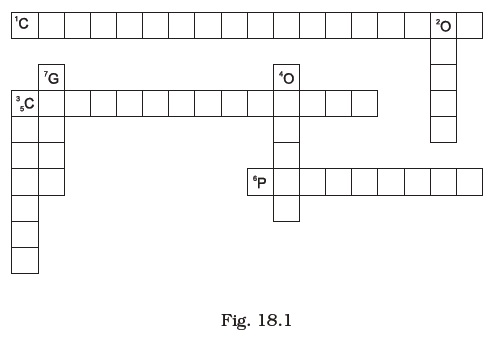
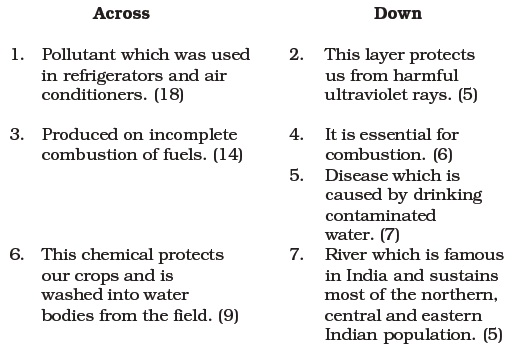
Click here to download the NCERT Exemplar Class 8 Science Unit 18 Pollution of Air and Water
Answers to Multiple Choice Questions
Mutiple Choice Questions


Very Short Answer Questions

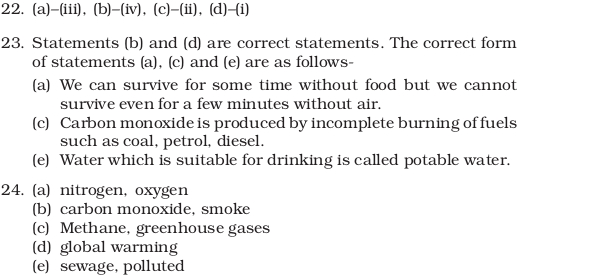
Short Answer Questions


Long Answer Questios
To get study material, exam alerts and news, join our Whatsapp Channel.

